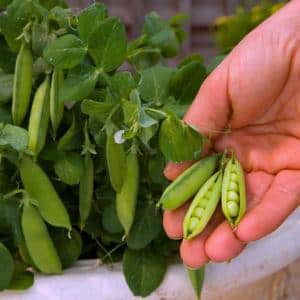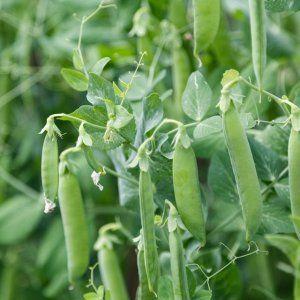Instructions for beginner gardeners: how to plant peas correctly to get a rich harvest
Peas are a self-pollinating annual plant. The crop belongs to the legume family. It began to be cultivated long before the appearance of the first civilizations in South-West Asia. Let's look at what varieties of this plant there are, when and how to plant peas, how to care for them, and when to harvest.
Types and varieties of peas
It is customary to distinguish sugar varieties that can be to eat together with the valves, since they do not have a hard parchment layer, and peeling ones, whose valves are inedible, but the fruits have an excellent taste.
Most famous such varieties, like Adagumsky, Ambrosia, Vera, Sphere, Era and others.
Landing dates
Peas refers to cold-resistant crops. It can withstand frosts down to minus 6 degrees. Therefore, you can sow it early, but it is not recommended to do this before April 20. Early ripening varieties can be planted until the beginning of July.
How to plant peas correctly
 It is best to plant peas where crops such as potatoes, cucumbers, pumpkins or cabbage grew last season. If you applied phosphorus or potassium fertilizers to these vegetables, that’s even better. The fruits will be more tender. You can plant peas with the same plants in the same bed.
It is best to plant peas where crops such as potatoes, cucumbers, pumpkins or cabbage grew last season. If you applied phosphorus or potassium fertilizers to these vegetables, that’s even better. The fruits will be more tender. You can plant peas with the same plants in the same bed.
How to plant peas in open ground correctly? It is not recommended to apply fertilizer immediately before planting, as this will stimulate the growth of tops of the plant, and there will be few fruits.For better results, place regular compost, a little urea and boric acid (0.5 teaspoon per 1 sq.m.) in the furrow.
Some summer residents warm the seeds in a thermos before planting. To do this, pour warm water (about 45 degrees) into a thermos and add peas there for several hours. While there, the seeds become saturated with moisture and swell. After this, they need to be taken out and dried. Peas treated in this way will sprout much earlier.
Many people are interested in whether it is possible to plant peas before winter? For these purposes, special varieties have been bred that produce a harvest in the second half of June. But they are suitable for the southern regions of our country. In northern latitudes, sprouts may die due to frost.
The culture loves light, so plant it in sunny areas where there is no wind. You can sow both dry and sprouted seeds. To protect seeds from pests, before planting, you can immerse them in hot water (+35 degrees) for 5 minutes, in which boric acid is diluted (about 2 g of acid per 10 liters of water).
For a good harvest, the crop must be planted correctly. To sow peas, you need to make furrows about 20 cm wide. The distance between rows should be about 50 cm. Place compost in the furrows. The distance between seeds is about 5 cm. The depth of planting seeds in clay soil is about 5 cm, in sandy soil it is 2-3 cm.
Shoots will appear in one to two weeks.
Pea care
Caring for peas is quite simple. All that is needed is to protect the seedlings from birds, weed, water and harvest on time.
Birds pose a great danger to young seedlings. Therefore, it is better to cover the beds. Fishing nets are best suited for this.
Peas do not tolerate hot weather very well, so during such periods they need to be watered abundantly - about 10 liters per 1 sq.m. Immediately after watering, it is recommended to loosen the soil.
Peas need support to grow properly. You can stretch a mesh with large cells onto the pegs, or simply tie twine horizontally.
Harvest and storage
 Approximately two months after sowing, the plant begins to bloom. A month after flowering, you can begin harvesting. Since this is a multi-harvested crop, the fruiting period can last for one and a half months. Fruits are usually harvested every 2-3 days.
Approximately two months after sowing, the plant begins to bloom. A month after flowering, you can begin harvesting. Since this is a multi-harvested crop, the fruiting period can last for one and a half months. Fruits are usually harvested every 2-3 days.
The first to ripen are the pods growing in the lower part of the bush. Under favorable conditions, up to 4 kg of crop can be harvested from one square meter of pea bed.
Freshly picked green peas cannot be stored for a long time. To preserve peas, they are frozen, canned, or dried in the oven with added sugar.
Dried peas can be stored for several years. However, it is not recommended to store it in paper, cloth or plastic bags, as pests can easily get in there. The best storage option is in closed glass jars.
Conclusion
Peas are a very useful and unpretentious crop. Growing it in the garden is not difficult even for novice gardeners.
If everything is done correctly, it will delight you with a bountiful and tasty harvest. But even after this he is able to do good service. Place the pea tops in a compost bin and use them as fertilizer next year. This will increase soil fertility and improve its structure.